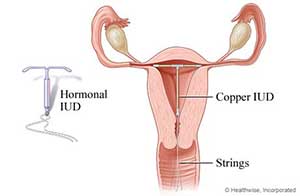
There are several choices. Which works best for you?
"It's easy to forget a pill every day and it's time-consuming to use something every time you have sex," says Christina, a 36-year-old mother of three children. "I just wish there were more birth control options for women." Like many women, Christina wonders if there is an easier alternative besides surgical sterilization or a daily pill. One alternative is an intrauterine device, more commonly called an IUD.
What is an IUD?
The modern IUD is a very small T-shaped piece of plastic that is inserted into a woman's uterus by a doctor. It is about as thin as a toothpick and as long as a small paper clip. Two short pieces of specialized thread hang from its end through the cervix so the doctor can easily remove it when it is no longer needed. The IUD prevents pregnancy better than birth control pills and is considered very safe. They can be used by both women who have had children, and those who have never been pregnant.
Intrauterine Devices

Source: Healthwise©, Inc.
How does it work?
IUDs work by disabling movement of the sperm into the fallopian tube so that it is unable to meet with an egg. The hormonal IUD thickens cervical mucus, which also interferes with sperms’ mobility. When a sperm and egg cannot meet, pregnancy cannot occur. Most women will continue to ovulate while the IUD is in place, even if they are not having cycles. A small percentage of ovulatory cycles can be suppressed in some women.
There are two types of IUDs available:
- Copper T Intrauterine Device (IUD)—This IUD is a small device that is shaped in the form of a “T.” It begins working as soon as it is in place and can stay in the uterus for up to 10 years. Typical use failure rate: 0.8%.
- Hormonal Levonorgestrel Intrauterine System (LNG IUD)—The LNG IUD is a small T-shaped device like the Copper T IUD. It releases a small amount of progestin each day to keep you from getting pregnant. The LNG IUD can take up to a week to start working, so be sure to use backup contraception during that time. It can stay in the uterus for up to 5 years. Typical use failure rate: 0.2%.
Some IUD Perks
- The hormonal LNG IUD frequently decreases menstrual bleeding and reduces cramping and discomfort in women who have heavy periods. For this reason it has uses outside of contraception for women who want better periods.
- Because an IUD lasts 5-10 years, it is extremely cost-effective. The greatest cost is having it put in, but after that there are no other expenses.
- Unlike the birth control pill, you do not need to remember to take something every day.
- Because it has little to no systemically available hormone it can be used in women who have medical conditions that preclude them from being able to take oral contraceptives.
IUD Side Effects
Overall an IUD has relatively few side effects. During the initial insertion some woman may feel:
- A little pain or discomfort
- Cramping
- Dizzy or lightheaded
After the insertion, a woman may have cramps and/or a backache for a couple of days. Less often, some may experience discomfort for a few weeks or months. Those using the copper IUD may experience heavier periods in the first few months. Over-the-counter pain medication is usually all that is needed to relieve these symptoms.
Rarely, woman may develop a pelvic infection after insertion or a perforation (hole) in the uterus. Your doctor will discuss potential side effects prior to the procedure.
How is the IUD inserted?
The procedure usually takes place at the physician’s, and is a relatively quick and easy procedure:
- The doctor washes the cervix with an antiseptic solution.
- A thin plastic tube containing the IUD is inserted through the cervix and into the uterus with a small plunger.
- The doctor removes the tube, leaving two small strings that dangle outside the cervix within the vagina.
With the first few cycles after placement, a woman can check to see that she can still feel the threads at the end of her cervix. Rarely and generally within the first few cycles the IUD can be expulsed, so checking the strings helps ensure that it is still in the right place. Your doctor may have you come back for a string check a few weeks after placing your IUD. Should your IUD come out, do not try to reinsert it yourself.
Remember that using an IUD does not protect you or your partner from sexually transmitted diseases. To do that you must use a male latex condom every time you have oral, vaginal, or anal intercourse.
Sources:
If you are thinking about contraception, talk to your doctor about all of your options. Dr. Alex Letham, with LewisGale Physicians Virginia Women’s Health is available to discuss the options, and answer any questions. To schedule an appointment, call the office at (540) 951-1550 or click the link below to schedule an appointment online.